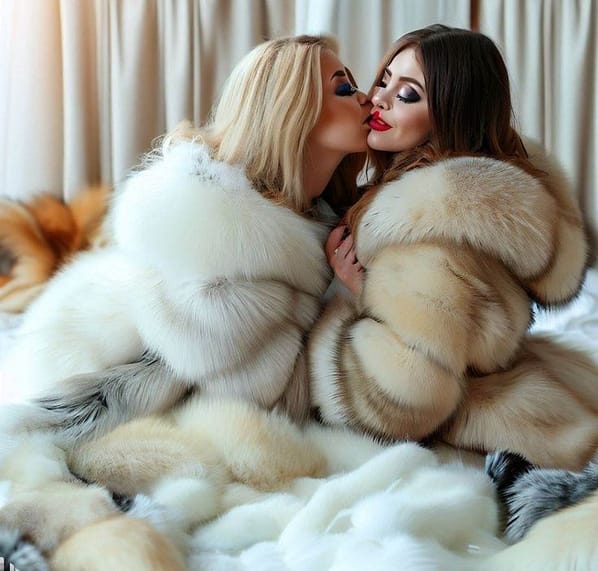Documented History of Transgender Wearing Real Fur Coats.
Here’s a breakdown of why:
-
Fashion and Self-Expression: Transgender wearing real fur coats have historically been associated with luxury, glamour, and status. People of all genders, including transgender people, might wear them for self-expression, regardless of gender identity.
-
Cross dressing and Fur: Sometimes, fur coats are associated with cross-dressing, which is when someone wears clothing typically associated with another gender. But, being transgender and cross dressing are not the same thing. A transgender woman might wear a fur coat to feel feminine, but it wouldn’t define her identity.

Cross Dressing in Fur
Here are some avenues for further exploration:
-
LGBTQ+ History and Fashion: You could look into the history of LGBTQ+ people and fashion trends throughout different eras. This might give you a broader context of how transgender people expressed themselves through clothing.
-
Social Commentary: Fur has also been used to make social statements. You could explore movements for or against fur and see if there’s any connection to transgender identity.
LGBTQIA2S Community Fur Coats and Couture Fashion Clothing

Multi Colored Fox Coat
The vibrant tapestry of LGBTQIA2S+ history and fashion is intricately woven with threads of self-expression, defiance, and a constant push for social change. While there’s no single, definitive narrative about the community’s relationship with real fur coats and couture fashion, exploring this intersection offers a glimpse into the complexities of identity, activism, and the ever-evolving fashion landscape.
Before the Storm: Conformity and Subtlety Transgender wearing real fur coats
Prior to the Stonewall Riots of 1969, the LGBTQIA2S+ community existed largely in the shadows. Societal pressures to conform were immense, and expressing one’s true identity through clothing was a risky proposition. Documentation from this era is scarce, but a few possibilities emerge:

Designer Turquoise Blue and lilac Fill length Mink Coat
-
Coded Fashion: Some LGBTQIA2S+ individuals might have used subtle sartorial choices to signal their identity to others within the community. This could have involved specific colors, patterns, or accessories, but wouldn’t necessarily extend to flamboyant displays of wealth like fur coats.
-
Passing for Survival: In a climate rife with discrimination, many LGBTQIA2S+ people prioritized blending in to avoid persecution. This meant adhering to mainstream fashion trends, regardless of personal preferences.
Transgender Wearing Full Length Fox Coat Paris
Post-Stonewall: Self-Expression Takes Center Stage
What is the history of the lgbtqia2s community wearing real fur coats and couture fashion clothing
The Stonewall Riots marked a pivotal moment in LGBTQIA2S+ history. The uprising ignited a movement for liberation, and self-expression through fashion became a powerful tool for activism and personal identity exploration. However, there wasn’t a monolithic trend of fur coats defining LGBTQIA2S+ fashion:
-
Reclaiming Luxury: Luxury items like fur coats and couture garments were traditionally associated with the elite, a group that often ostracized LGBTQIA2S+ people. By wearing these garments, some might have been reclaiming symbols of power and status that had been denied to them.
-
Gender Fluidity and Performance: Couture fashion, with its emphasis on theatricality and experimentation, offered a platform to challenge rigid gender norms. This could have resonated with LGBTQIA2S+ individuals who identified outside the gender binary.
Rainbow Fox Full Length Coat
Camp and Drag: Pushing the Boundaries
The concept of “camp” within LGBTQIA2S+ culture celebrates the artificial, the theatrical, and the flamboyant. Drag performance, a vibrant art form where performers embody a specific gender identity (often exaggerated), often incorporates elaborate costumes that could include fur. However, it’s crucial to remember that drag shouldn’t be seen as representative of the entire LGBTQIA2S+ community’s fashion choices.
The Rise of Ethics and Sustainability

Tourmaline Mink Coat
The latter part of the 20th century saw a growing awareness of animal cruelty in the fur industry. This, coupled with increasing environmental concerns, led to a decline in the use of real fur. Many LGBTQIA2S+ people, along with the general public, embraced cruelty-free alternatives, demonstrating a shift in values.
Modern LGBTQIA2S+ Fashion: Breaking Barriers
Today, LGBTQIA2S+ designers and fashion icons are at the forefront of pushing boundaries in the fashion world:
-
Gender-Fluid Revolution: Designers are incorporating elements of both traditionally masculine and feminine styles, creating a more inclusive fashion landscape that celebrates diversity.
-
Sustainable Statements: Many LGBTQIA2S+ individuals are environmentally conscious and choose sustainable materials over fur. This commitment is reflected in the growing popularity of eco-friendly fashion brands.
Black Sheared Mink Coat Mixed White Mink Fox Collar
Case Studies: Spotlighting Individual Expression
While a singular history of the entire LGBTQIA2S+ community and fur/haute couture is elusive, here are some individual stories that illustrate the complexities of fashion and identity:
-
Marsha P. Johnson: A prominent figure in the Stonewall Riots, Marsha P. Johnson was known for her flamboyant and colorful fashion sense. While there’s no record of her specifically wearing fur, her bold use of clothing embodied the spirit of rebellion and self-expression.
-
Gilbert Baker: The creator of the Rainbow Pride Flag, Gilbert Baker, was a gay rights activist who often wore leather jackets, a symbol of defiance against societal norms. This highlights how fashion choices can be a form of activism that transcends specific garments like fur coats.
-
Mj Rodriguez: Mj Rodriguez, a transgender actress known for her role in “Pose,” embraces a glamorous style on and off-screen. However, she is a vocal advocate for animal rights and would likely choose cruelty-free alternatives to fur.
Looking Forward: A Future of Inclusivity and Sustainability
The LGBTQIA2S+ community continues to be a powerful force for change in the fashion industry. As the focus shifts towards inclusivity, sustainability, and celebrating a spectrum of identities, as the sales of furs increase.

White Fox Coat





